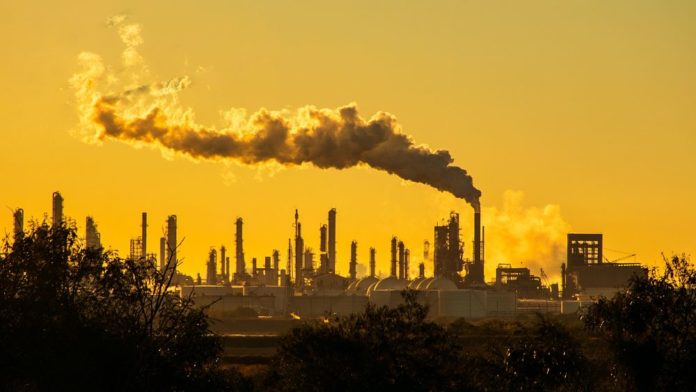For our latest Climate Now Debate, broadcast live from COP28, we’ll be discussing whether an emissions peak is in sight for greenhouse gases.
Despite repeated warnings from climate scientists, greenhouse gas emissions (GHGs) are still rising. From wildfires in Europe to floods in Pakistan, the reverberations of our failure to reduce emissions are being felt on a global scale. The IPCC says emissions must peak before 2025 if we are to meet the targets of the Paris Agreement, but time is rapidly running out.
Our expert panel of climate scientists and policymakers will be debating why GHGs are still rising live from COP28 in Dubaion December 5 at 10.00 am CET (1 pm UAE Time).
You can watch the debate in this article or on Euronews’ YouTube Channel.
While there has been some progress – since the agreement was signed in 2015, predicted GHG emissions in 2030 have fallen by 13 per cent – drastic cuts still need to take place if warming is to be limited. In fact, the UN Environment Programme (UNEP) states in its Emissions Gap 2023 Report, that projected emissions need to fall by a further 28 per cent by 2030 to stay within the Paris Agreement 2°C pathway. To have any hope of meeting the 1.5°C pathway target, they need to fall by a huge 42 per cent.
With GHGs rising by 1.2 per cent between 2021 and 2022, and with emissions reaching a record high of 57.4 Gigatonnes of Carbon Dioxide Equivalent (GtCO2e) in the same year, according to the UNEP, is there any hope of emissions peaking in time?
To find out the answers to these questions and more tune in to the debate. The live event also ties in with the release of the latest Climate Action Tracker report, which we will be discussing with our guests.
Our panellists are:
Bertrand Piccard, Chairman, Solar Impulse Foundation
Mia Moisio, Climate Action Tracker
Moderator, Jeremy Wilks, Euronews
Why are emissions still rising and what does this mean for the atmosphere?
Despite repeated warnings of the consequences, along with an increase in extreme weather events, GHG emissions continue to rise.
While EU countries such as Spain have committed to phasing out coal mines by 2030, and the US closed down 13.5 gigawatts of coal-powered energy capacity in 2022, there was still a 1 per cent rise in coal capacity in 2022. This was due to 44.5 GW of commissioned capacity opening in China. The cost of war is also taking its toll, with the Ukraine government estimating that by October 2022, the Ukraine war had released 31 million tonnes of CO2 into the atmosphere.
This continued rise is having real-world impacts, and according to the Emissions Gap Report, from the start of 2023 until the beginning of October, there were 86 days with temperatures over 1.5°C above pre-industrial levels.
While data collected by The Copernicus Climate Change Service and the ERA5 dataset, the European Centre for Medium-Range Weather Forecasts (ECMWF) shows that 17 November 2023 was the first day that global temperatures exceeded 2°C above pre-industrial levels.
With so much at stake, COP28 will bring us the conclusion of the first Global Stocktake, a mechanism that will take a long, hard look at global attempts to meet the targets enshrined in the Paris Agreement.
Our panel will be discussing the likely results of the Global Stocktake and what this will mean for the future of the Paris Agreement on December 5.
What is the Global Stocktake and will it hold polluters to account?
Set to conclude at COP28 this year, the first Global Stocktake will analyse attempts to mitigate GHG emissions since the Paris Agreement 2015, while also looking at any progress towards adaptation.
While the Stocktake won’t name and shame any individual countries, given the severity of the UN’s Emissions Gap Report, it is unlikely to heap praise on international efforts thus far.
Further stocktakes will take place every five years, with the next one due in 2028. The UN hopes the stocktake will give governments a chance to accelerate their efforts in time for the next round of climate action plans, which are due in 2025.
What else is being done to reduce emissions?
While emissions need to peak before 2025 to stay below 1.5°C warming, unless drastic cuts are made now, this is looking increasingly unlikely.
Beyond the Global Stocktake, there are a number of other bodies that are trying to hold governments to account.
The Climate Action Tracker (CAT) will release its latest report on December 5, to tie in with COP28’s ‘Climate Law and Governance Day’. An independent scientific project, it tracks government climate action, measuring it against the Paris Agreement’s aim of “holding warming well below 2°C”.
A collaboration between Climate Analytics and NewClimate Institute, the CAT has been providing independent analysis to policymakers since 2009.
Alongside pressure from CAT, the EU is hoping to limit “carbon leakage” – which happens when companies based in the EU move carbon-intensive production to non-EU countries with less stringent climate policies. The EU’s Carbon Border Adjustment Mechanism (CBAM) aims to put a fair price on the carbon emitted during the production of carbon-intensive goods entering the bloc, both to encourage cleaner production and ensure its climate objectives aren’t undermined.
The EU’s Methane Strategy is also set to be formally adopted in December, while the Solar Impulse Foundation has devised 1,000 solutions that they hope will address environmental challenges without compromising economic growth.
Will these projects be enough to bring about the rapid mitigation needed? And are peak emissions in sight? To find out, join us live from COP28 in Dubai on the 5 December at 10.00 am CET (1 pm UAE Time).


